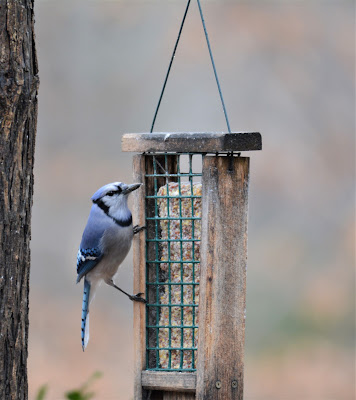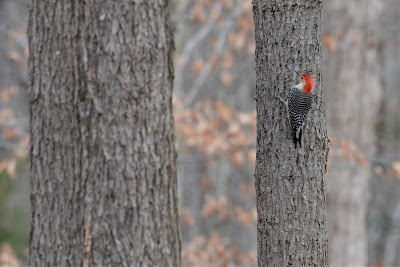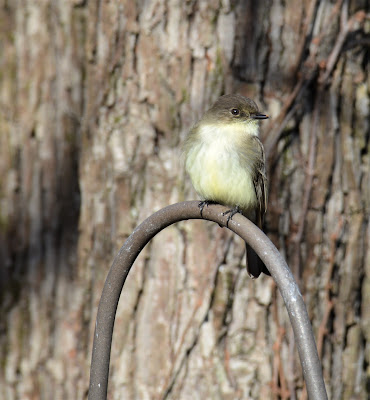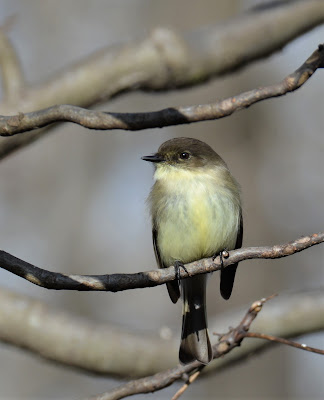Pops of Color in Winter Wildlife Garden
It's been a dreary, wet winter and I feel the chill in my bones. As I look out into our back garden I'm hit with uninspiring, muted tones. The trees are mostly bare, the ground a blanket of brown leaf litter and I find myself weary of winter. More of a warm weather gal, I am longing for the pastel tones of the spring landscape that will kick start the growing season. I often find solace in the quiet season, but this year I am yearning for color.
We often think of adding texture and color to our winter gardens through plants, from berries and flowers, and colorful branches or vibrant foliage, but there's another way to make your garden come alive. Birds that are year-round or over wintering in your area provide wonderful pops of bold color that travel throughout the landscape like moveable art.
Here are a few of my favorites from our winter garden.
Male pine warblers provide a cheerful burst of yellow against the subdued background. Their normal diet of insects is harder to come by during winter months , so we often see them creeping along branches before they fly down to feeders that contain suet and sunflower seeds.
They will forage in leaf litter searching for dormant insects, but even then, their tiny, yellow bodies are sunshine against the brown foliage.
During the winter months the pine warblers often forage alongside another insectivore, the eastern bluebirds. Our bluebird population has exploded over the past few years, partly due to nesting boxes that we've added over the years, as well as the increasing number of insects available to them as a result of sustainable gardening practices. Bluebirds sport my favorite color blue, and their cobalt plumage is incredibly brilliant. Even their brick red brown throat and chest is vivid.
 |
Another 'blue' bird, the Blue Jay, can't be missed with its loud call and bright coloring. Not always a favorite, I think they have gorgeous feathers. Visiting feeders in search of suet, sunflowers, or peanuts these assertive birds will certainly liven up the winter doldrums.
Male Northern cardinals provide big bursts of color as they glide from one tree to another. It's hard not to be happy when you see this striking red bird.
Even though the male cardinals are spicier, the orange on the female's beak and wing feathers still contribute a nice bit of color.
Woodpeckers are energetic foragers, scurrying up and down the tree trunks in search of food. The male red-bellied woodpeckers are easy to spot with their bright nape that pops against the gray-brown textured tree trunks.
The smaller downy woodpecker is usually first heard before seen, as it drums vigorously on the side of trees. The male's red nape is easy to spot against it's black and white feathers.
A little more subtle, but still providing some rays of sunshine on an overcast day, are the phoebes. These flycatchers will come to the feeders for mealworms during winter months.
Their pale yellow belly, albeit understated, does add warmth to the somber background while they actively whip their tails around.
The tufted titmouse is another bird that, from the distance, would fade into the background if it weren't for its constant movement and cheery disposition. These small birds don't stay still for long, but when they do, their brownish orange accent stands out against their gray feathers and picks up the tones of the marcescent red oak tree leaves. During winter months titmice join other families of their clan, including chickadees, nuthatches, and small woodpeckers roaming the woods in search of food.
You can invite an abundance of winter birds into your landscape that will deliver those fun bursts of color in your winter landscape by providing food sources for them.
- Keeping a organic, sustainable garden provides food for insectivores.
- Including trees and shrubs that bear fruit during the winter months supports frugivores.
- Incorporating native grasses into your landscape, while not cutting back flowering perennials such as sunflowers, coneflowers, and other wildflowers until spring feeds granivores.
- Hang a few bird feeders that include suet, mealworms, peanuts and seeds.

















.png)
